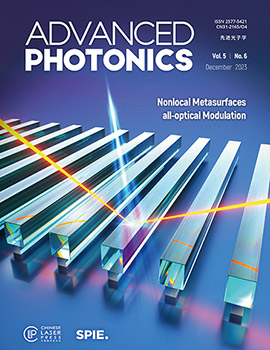Revealing the behavior of soliton buildup in a mode-locked laser
IF 18.8
1区 物理与天体物理
Q1 OPTICS
引用次数: 90
Abstract
Abstract. Real-time spectroscopy based on an emerging time-stretch technique can map the spectral information of optical waves into the time domain, opening several fascinating explorations of nonlinear dynamics in mode-locked lasers. However, the self-starting process of mode-locked lasers is quite sensitive to environmental perturbation, which causes the transient behaviors of lasers to deviate from the true buildup process of solitons. We optimize the laser system to improve its stability, which suppresses the Q-switched lasing induced by environmental perturbation. We, therefore, demonstrate the first observation of the entire buildup process of solitons in a mode-locked laser, revealing two possible pathways to generate the temporal solitons. One pathway includes the dynamics of raised relaxation oscillation, quasimode-locking stage, spectral beating behavior, and finally the stable single-soliton mode-locking. The other pathway contains, however, an extra transient bound-state stage before the final single-pulse mode-locking operation. Moreover, we propose a theoretical model to predict the buildup time of solitons, which agrees well with the experimental results. Our findings can bring real-time insights into ultrafast fiber laser design and optimization, as well as promote the application of fiber laser.揭示锁模激光中孤子积累的行为
摘要基于一种新兴的时间拉伸技术的实时光谱学可以将光波的光谱信息映射到时域,从而开启了锁模激光器非线性动力学的几个有趣的探索。然而,锁模激光器的自启动过程对环境扰动非常敏感,导致激光器的瞬态行为偏离了孤子的真实积累过程。我们对激光系统进行了优化,以提高其稳定性,从而抑制了环境扰动引起的调q激光。因此,我们首次在锁模激光中观察到孤子的整个形成过程,揭示了产生时间孤子的两种可能途径。其中一条途径包括提高弛豫振荡的动力学,准锁模阶段,谱跳动行为,最后是稳定的单孤子锁模。然而,在最后的单脉冲锁模操作之前,另一个路径包含一个额外的瞬态束缚态阶段。此外,我们还提出了一个预测孤子积累时间的理论模型,该模型与实验结果吻合较好。我们的研究结果可以为超快光纤激光器的设计和优化提供实时见解,并促进光纤激光器的应用。
本文章由计算机程序翻译,如有差异,请以英文原文为准。
求助全文
约1分钟内获得全文
求助全文
来源期刊

Advanced Photonics
OPTICS-
CiteScore
22.70
自引率
1.20%
发文量
49
审稿时长
18 weeks
期刊介绍:
Advanced Photonics is a highly selective, open-access, international journal that publishes innovative research in all areas of optics and photonics, including fundamental and applied research. The journal publishes top-quality original papers, letters, and review articles, reflecting significant advances and breakthroughs in theoretical and experimental research and novel applications with considerable potential.
The journal seeks high-quality, high-impact articles across the entire spectrum of optics, photonics, and related fields with specific emphasis on the following acceptance criteria:
-New concepts in terms of fundamental research with great impact and significance
-State-of-the-art technologies in terms of novel methods for important applications
-Reviews of recent major advances and discoveries and state-of-the-art benchmarking.
The journal also publishes news and commentaries highlighting scientific and technological discoveries, breakthroughs, and achievements in optics, photonics, and related fields.
 求助内容:
求助内容: 应助结果提醒方式:
应助结果提醒方式:


